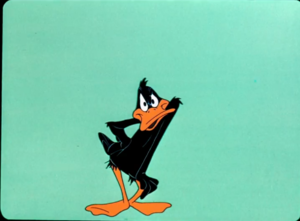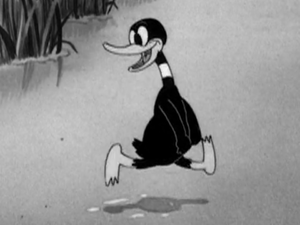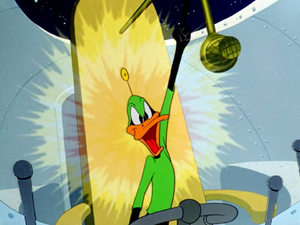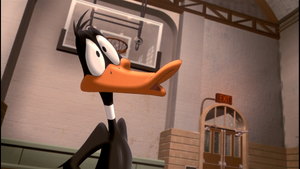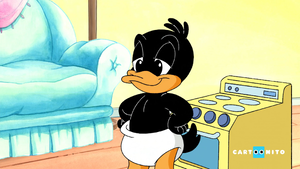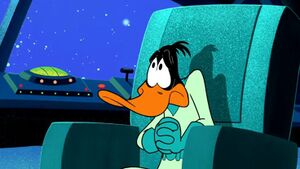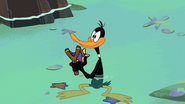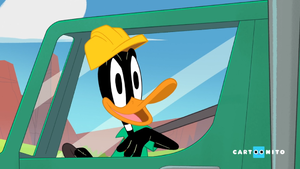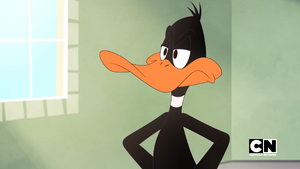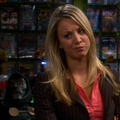- This article is about the character. For other uses, see Daffy Duck.
Daffy Duck is an anthropomorphic duck and a main character of the Looney Tunes and Merrie Melodies theatrical shorts, in which he is usually depicted as a foil for either Bugs Bunny, Porky Pig or Speedy Gonzales. Created by animators Tex Avery and Bob Clampett, he was the first of the new "screwball" type characters that emerged in the later part of the 1930s to replace traditional everyman characters who were more popular earlier in the decade. His voice was originated by Mel Blanc.
Daffy starred in 130 shorts in the golden age of American animation, making him the third-most frequent character in the Looney Tunes/Merrie Melodies cartoons, behind Bugs' 167 appearances and Porky's 153 appearances. Daffy's personality and roles varied with virtually every Warner Bros. cartoon director; Bob Clampett and Chuck Jones notably made extensive use of two versions of the character, depicting him as either a wild, lunatic vigilante or a greedy, fame-seeking foil, respectively.
Daffy has a space hero persona called Duck Dodgers, and his protégé in Tiny Toon Adventures is Plucky Duck.
Character description
Daffy's personality is multifaceted and wildly varies throughout his appearances. Initially, the duck was merely depicted as a zany screwball with an unpredictable mind of his own. However, as the character evolved through the late 1940s to early 50s, Daffy was recast as an intensely egotistical duck who often seeks reputation and validation.
In his "screwball" incarnation, Daffy is known for his brash, confident, and over-the-top behavior. He is very unrestrained when it comes to having strong emotions, often experiencing fits of pure excitement. Daffy's actions are usually fast-paced, as he can either go from unassuming to wild in a blink of eye. His common behavioral traits include bouncing and spinning uncontrollably, as well as shouting "Woo-hoo!" repeatedly in a state of joy. Daffy tends to seek in the thrill of provoking others, whether it's targeting authority figures in an act of rebellion, or exploiting the weaknesses of characters such as Porky Pig. In spite of his perceived insanity, Daffy can occasionally be carefree at times, especially in moments where he doesn't feel provoked.
In the refined personality developed by Friz Freleng and Chuck Jones, Daffy is portrayed as a self-absorbed and explosive individual with a competitive streak. He is mostly neurotic and determined to seek all sorts of attention, an aspect that is very evident by his jealousy with Bugs Bunny, whom he views as one-sided rival. At his most extreme, Daffy is consumed by envy and greed, much to his own detriment. While retaining some traits from his early loony personality, Daffy tends to have dramatic tenancies with a playful edge, but makes up with it by having a complex display of introspective emotion—ranging from insecurity to self-pride. Though not entirely selfish in his goals, Daffy tries to put on schemes in a feeble attempt to become successful, only to backfire on him repeatedly.
Similarly, his physical appearance also varies, but is consistently portrayed as a black-feathered duck with a white ring on his neck. In his early theatrical output from the 1930s, he resembled more of an actual duck with short limbs, narrow beak and pear-shaped body. However, his design slowly took on a more humanoid appearance as he both gained a sleek physique and wider bill in later entries by the late 1940s.
Appearances
TV series
Movies
Specials
Shorts
- Main article: List of Daffy Duck shorts
Comics
Video games
Theme parks
Podcasts
Biography
Original Cartoons
The Early Years
Daffy first appeared in the 1937 short Porky's Duck Hunt, in which he is cast as a duck who merely acted crazy. Here, Daffy (despite being played as a bit player in the short) acted as a comic foil to Porky Pig, constantly switching from being an unassuming avian to "a crazy darn-fool duck" in an instant. He is established in this short as a zany screwball, which permeated in his appearances up until around the late-1940s.
In Daffy Duck & Egghead (1938), Daffy first plays a more prominent role when he is targeted by a hunter named Egghead. In one notable scene, Daffy sings a variation of "The Merry-Go-Round Broke Down" and says his own name for the first time.
In Porky & Daffy (also 1938), Daffy is further established as Porky's partner, in which Porky is a straight-lace manager to his "puny" boxer role. This relationship would last in various cartoons directed by Bob Clampett up until around 1946, who portrayed either Daffy as a loony sidekick that acted out in frantic gags to Porky's hapless personality, or a happy-go-lucky lunatic who likes to mess with him (or vice versa).
Daffy first showed signs of his egotistical streak in Friz Freleng's 1940 short You Ought to Be in Pictures, where he schemes to get Porky to resign his film contract from producer Leon Schlesinger, and attempts to convince the latter in making him the new star of Warner Bros. cartoons. His plan was backfired when Porky discovers his ruse and ends up beating him up senseless.
Wartime Era
Daffy appeared in several war-themed cartoons during World War II, with most of them acting as propaganda to support victory for the Allies, and showcase his unfiltered energy. In Scrap Happy Daffy (1943), Daffy encouraged the support of recycling scrap metal to the U.S. Army, all while battling wits with a Nazi goat. In Daffy – The Commando (also 1943), Daffy flies to a German bunker to face Commander Von Vultur, and eventually whacks Adolf Hitler in Berlin. In Plane Daffy (1944), Daffy becomes an American messenger to evade the seductive charms of the Nazi spy Hatta Mari. Oddly enough, Daffy became a subject of conscription into military service in Draftee Daffy (1945), where he tries to dodge himself from "the little man from the draft board".
Duck Season, Fire!
| This article or section is a stub. You can help the Looney Tunes Wiki by expanding it.
|
Other Personas
| This article or section is a stub. You can help the Looney Tunes Wiki by expanding it.
|
Chasing with Speedy
| This article or section is a stub. You can help the Looney Tunes Wiki by expanding it.
|
It's a Looney, Looney, Looney, Looney, World
| This article or section is a stub. You can help the Looney Tunes Wiki by expanding it.
|
Fantastic Island
| This article or section is a stub. You can help the Looney Tunes Wiki by expanding it.
|
1000 Rabbit Tales
| This article or section is a stub. You can help the Looney Tunes Wiki by expanding it.
|
Who Ya Gonna Call?
| This article or section is a stub. You can help the Looney Tunes Wiki by expanding it.
|
We're All a Little Looney
| This article or section is a stub. You can help the Looney Tunes Wiki by expanding it.
|
It's Time for Animaniacs!
| This article or section is a stub. You can help the Looney Tunes Wiki by expanding it.
|
Come On and Slam! And Welcome to the Jam!
| This article or section is a stub. You can help the Looney Tunes Wiki by expanding it.
|
Duck Dodgers of the 24th and One Half Century
| This article or section is a stub. You can help the Looney Tunes Wiki by expanding it.
|
The Baby Looney Tunes Way
| This article or section is a stub. You can help the Looney Tunes Wiki by expanding it.
|
Daffy Gets Modern
| This article or section is a stub. You can help the Looney Tunes Wiki by expanding it.
|
In The Looney Tunes Show, he is Bugs Bunny's freeloading roommate and best friend.
Going Down the Rabbit Hole
| This article or section is a stub. You can help the Looney Tunes Wiki by expanding it.
|
Back to Basics
| This article or section is a stub. You can help the Looney Tunes Wiki by expanding it.
|
Jamming in the Serververse
| This article or section is a stub. You can help the Looney Tunes Wiki by expanding it.
|
It's Hard Hat Time
| This article or section is a stub. You can help the Looney Tunes Wiki by expanding it.
|
Educating in Looniversity
| This article or section is a stub. You can help the Looney Tunes Wiki by expanding it.
|
Daffy Sells Out
Daffy has a cameo in the opening of The Drew Carey Show episode "My Best Friend's Wedding," asking the title character for a reporting job, which he is denied because they don't hire ducks. He kisses Mimi Bobeck, who slaps him in return, and as a parting gift to Drew, leaves TNT in his office.
Hysteria
| This article or section is a stub. You can help the Looney Tunes Wiki by expanding it.
|
Daffy in the Funny Books
Dell
| This article or section is a stub. You can help the Looney Tunes Wiki by expanding it.
|
Gold Key
| This article or section is a stub. You can help the Looney Tunes Wiki by expanding it.
|
DC Comics
| This article or section is a stub. You can help the Looney Tunes Wiki by expanding it.
|
Why So Serious?
| This article or section is a stub. You can help the Looney Tunes Wiki by expanding it.
|
Development
Daffy first appeared in Porky's Duck Hunt, released on April 17, 1937,[2] and directed by Tex Avery and animated by Bob Clampett. Duck Hunt contained a standard hunter/prey pairing, but Daffy (who had barely been more than an unnamed bit player in this short) was something of a new concept to moviegoers: an assertive, completely unrestrained, combative protagonist. Clampett later recalled:
"At that time, audiences weren't accustomed to seeing a cartoon character do these things. And so, when it hit the theaters it was an explosion. People would leave the theaters talking about this daffy duck."[3]
The early Daffy in this short was less anthropomorphic and more or less resembles a normal black duck. In fact, the only aspects of the character that have remained consistent through the years are his voice characterization by Mel Blanc; and his black feathers with a white neck ring. Overtime, when Clampett took over directorial duties on the Daffy shorts, the character was gradually redesigned to look more anthropomorphic, resembling more of a human than a duck.
The origin of Daffy's voice, specifically his lateral lisp, is a matter of some debate. One oft-repeated story was that it was modeled on producer Leon Schlesinger's tendency to lisp. In Mel Blanc's autobiography That's Not All Folks!, he contradicts that conventional belief, writing, "It seemed to me that such an extended mandible would hinder his speech, particularly on words containing an s sound. Thus 'despicable' became 'desth-picable.'"[4]
Daffy wasn't officially named until the 1938 Merrie Melodies short Daffy Duck & Egghead, in which he was paired with Egghead.
Gallery
- Main article: Daffy Duck (character)/Gallery
Toys and merchandise
- Main article: Daffy Duck (character)/Toys
Behind the scenes
- Daffy's manic laugh ("Woo-hoo! Woo-hoo!") was reportedly inspired by a similar tagline from comedian Hugh Herbert ("Hoo-hoo!").[5]
- Daffy is known to have a middle name of differing accounts:
- In The Scarlet Pumpernickel, he addresses himself as "Daffy Dumas Duck" when reading his movie script.
- In the Baby Looney Tunes episode "Tattletale", Granny addresses him as "Daffy Horatio Tiberius Duck".
- In The Looney Tunes Show, "Armando" and "Sheldon" are jokingly used for Daffy's full name. In "Best Friends," he prefers to use "Armando" because he thought it sounded cool, though he changes back to using "Sheldon" in "Bugs & Daffy Get a Job".
- In Baby Looney Tunes, Daffy is credited as "Baby Daffy."
- Since Teen Titans Go! To the Movies in 2018, the Warner Bros. Animation logo has Daffy coming out of the logo, going crazy, messing with the logo and running around while laughing before hitting the screen and being pulled away by Porky.
- For the logo's variation in Mortal Kombat Legends: Scorpion's Revenge, Scorpion replaces Porky and pulls Daffy straight to the Netherrealm. The original idea was to have Daffy be stabbed in the head by Scorpion's kunai, although it was rejected by Warner Bros.
In popular culture
- In the 1977 movie Close Encounters of the Third Kind, Roy wakes up one morning to find his daughter watching Duck Dodgers in the 24½th Century on TV. The scene where Dodgers delivers a message to Marvin is shown on the TV as she watches it.
- Daffy famously appeared alongside Donald Duck in the 1988 Disney film Who Framed Roger Rabbit, where he is seen challenging Donald to piano duel at the bar.
- In the 1989 film UHF, starring "Weird Al" Yankovic, there is a poster of Bugs and Daffy in his character's apartment.
- In the July 7, 1994 episode of Top of the Pops, a teenage girl wears a Daffy t-shirt while dancing to Aswad's "Shine."
- In The Drew Carey Show episode "Drew's the Other Man," a black and white photo of Daffy is shown during the dance montage to Tower of Power's "What Is Hip?"
- In the Family Guy episode "The Story on Page One," after Meg is blown up by a bomb, she suddenly has a beak, which is turned upside down just like Daffy's in Rabbit Fire.
- In the Only Fools and Horses 2001 Christmas special, If They Could See Us Now, Del catches Rodney wearing a gladiator costume to role-play with his wife who is dressed as a police officer. He is supposed to look like Russell Crowe as Spartacus from the movie Gladiator, which Del agrees with, right before leaving the flat, and immediately says to himself how Rodney looks more like Daffy Duck.
- On June 10, 2003, Daffy, as Duck Dodgers, appears as a lauch patch for the NASA Mars Rover Exploration mission.
- In The Big Bang Theory episode "The Excelsior Acquisition," Stuart, owner of the Comic Center of Pasadena, exchanges Stan Lee's home address with Penny to be his date to his cousin's wedding, Looney Tunes #179 is just about visible behind her, with Daffy visible in the character icon.
- In the Batwoman episode "Fair Skin, Blue Eyes," young Ryan visits Galaxy Comics, with Looney Tunes comics in a stand at the front, which includes Looney Tunes #235 and #239 with Daffy on the covers.
- In the 2020 film Sonic the Hedgehog, Tom helps three ducks cross the street, naming them Donald, Daisy, and Daffy.
- In the 2023 film The Flash, the alternate 2013 version of Barry Allen has a Looney Tunes background screen on his computer, which includes Daffy, Sylvester, Bugs, Road Runner, Wile E., and Tweety.
- In the Velma episode "Private Velmjamin," Fred wants to return a nativity miniature model with the Looney Tunes to Father O'Rourke, after Fred briefly became Catholic. Elmer Fudd is baby Jesus, Sylvester as Joseph, Granny as Mary, and Daffy, Porky, and Bugs as the three wise men.
- In the Paradise PD episode "Sack to the Future", Kevin attempts to convince his past self not to shoot him by saying it's actually duck season. The camera pans to Daffy, who is confused on why he's here but cusses out Kevin anyway.
Full House
- "Middle Age Crazy," "Fogged In," "Working Mothers, "Pal Joey," "El Problema Grande de D.J.," "Blast from the Past," "Nerd for a Day," "Joey & Stacy and... Oh, Yeah, Jesse," "Those Better Not Be the Days," "The I.Q. Man," "Terror in Tanner Town," and "Happy New Year:" A 1986 Looney Tunes poster was added to Joey's bedroom in the second season onwards, featuring Bugs, Daffy, Porky, Sylvester, Road Runner, and Tweety.
- "13 Candles:" Stephanie says to D.J. she and Joey are going to a Daffy Duck film festival, with Joey saying in a Daffy voice, "And after, we'll go out for pizza," spitting in Joey's eye in the process. Joey apologises, but says "Sorry" in Daffy's voice, spitting him in the eye again. Later, Joey says in a spitting lisp that the Daffy Duck festival was "thoroughly stimulating" when asked how it was by Jesse.
- "Take My Sister, Please:" Joey impresses Lisa with his impression of Daffy Duck.
- "Spellbound:" Joey wants Jesse to watch his tape of cartoons for inspiration in writing the former a cartoon theme song, which according to Joey, who speaks in Daffy's spitting lisp, will make Jesse a "Cartoon aficionado."
- "Taking the Plunge:" Joey attempts to intimidate the Queen's royal guard by doing a Daffy Duck impression, and says, "Sufferin' succotash! You, sir, are inscrutable!" Joey gets kicked by the guard in response to his threat.
Robot Chicken
- Main article: Robot Chicken
- "Rodiggiti:" During "8 Carrot," Daffy is the host of Bugs and Elmer's Rap Battle.
- "Immortal:" In the skit "Porky's," Bugs and Daffy mistake a strip club called Porky's for a place that Porky Pig owns, only to be proven wrong. Although they were appalled by what they saw in the strip club, they immediately go back in.
Notes
References
- ↑ A-Haunting We Will Go (1966)
- ↑ Beck, Jerry; Friedwald, Will (1989). Looney Tunes and Merrie Melodies: A Complete Illustrated Guide to the Warner Bros. Cartoons. Henry Holt and Co. p. 55. ISBN 0-8050-0894-2.
- ↑ Schneider. "That's All Folks!: The Art of Warner Bros. Animation": 150.
- ↑ Blanc, Mel; Bashe, Philip (1989). That's Not All, Folks!. Clayton South, VIC, Australia: Warner Books. ISBN 0-446-51244-3.
- ↑ Lenburg, Jeff (1991). The Encyclopedia of Animated Cartoons, 1991 edition. Checkmark Books. p. 64. ISBN 0-8160-2252-6.
